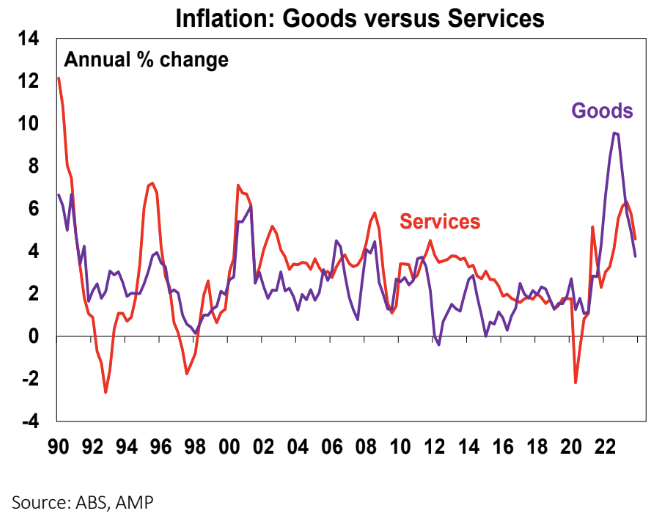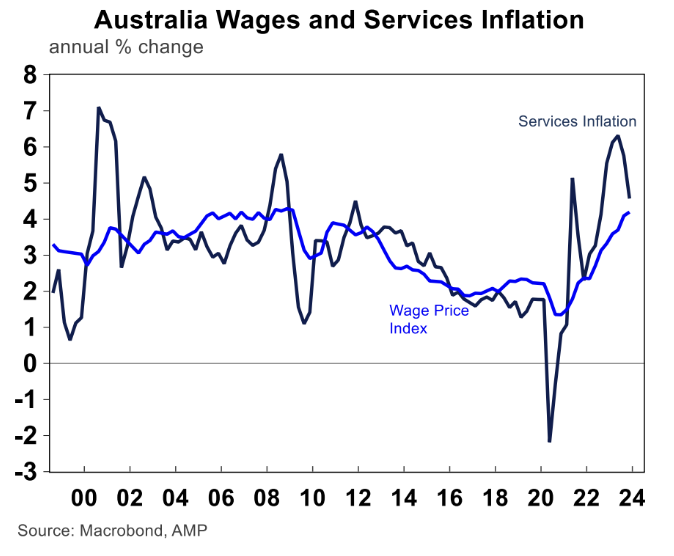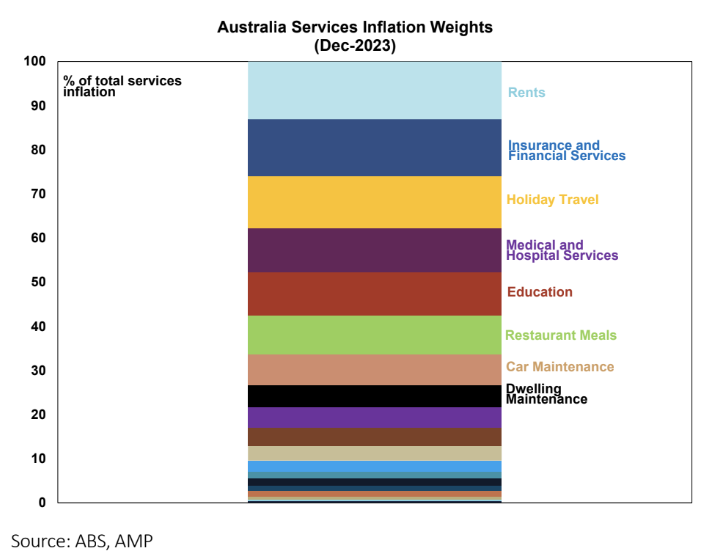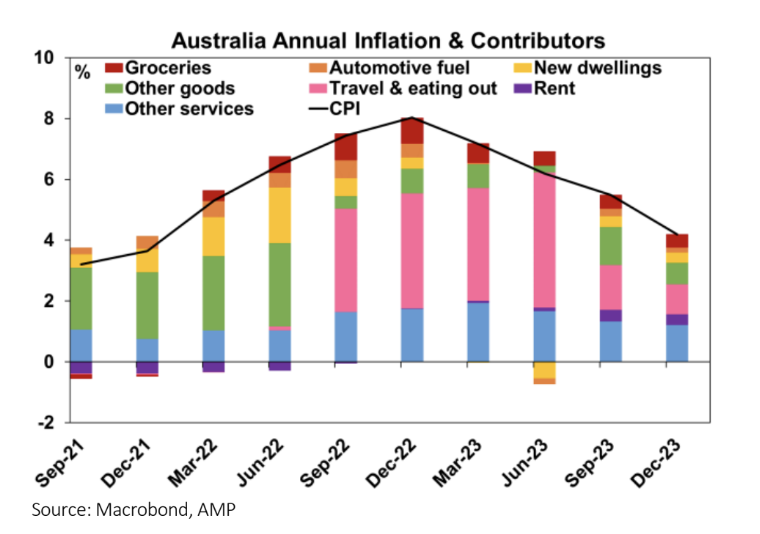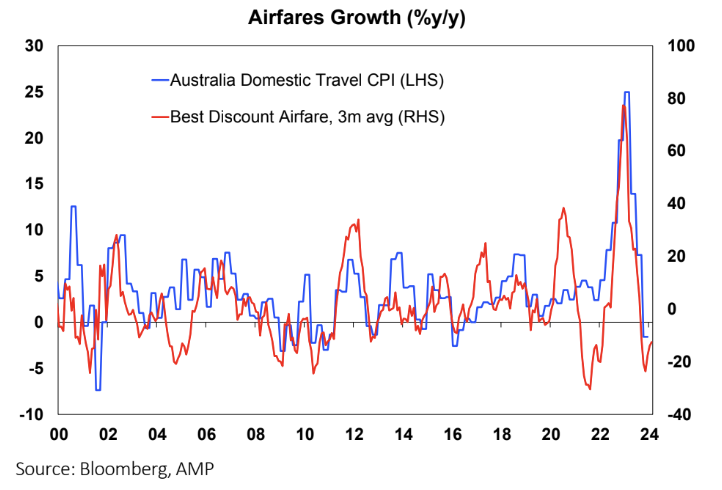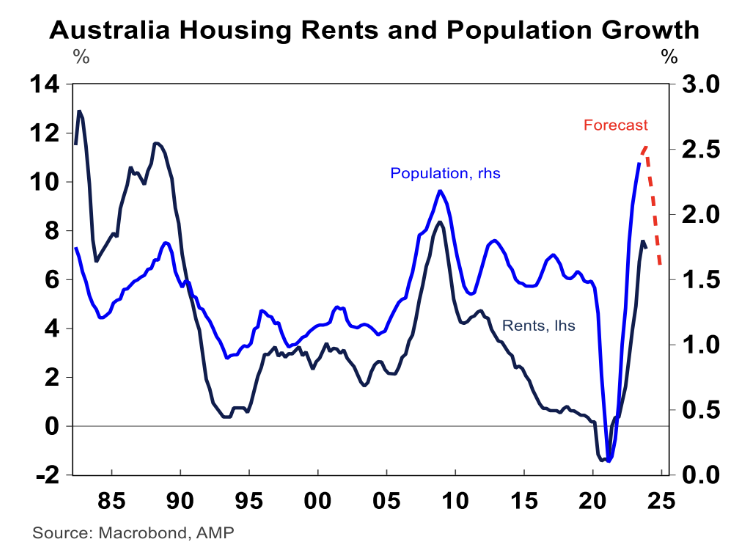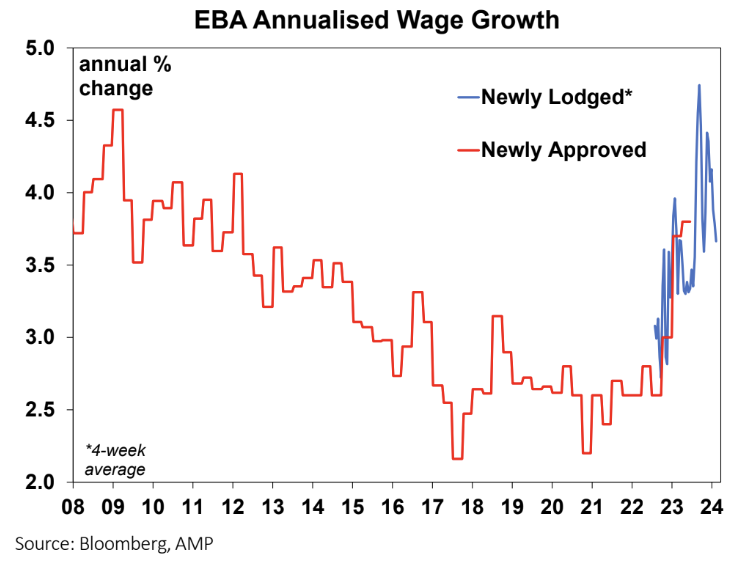The Reserve Bank of Australia is forecasting a further slowing in inflation to 3.3% by June and 3.2% by December and these forecasts are underpinned by expectations of a further moderation in services inflation. Goods inflation has more than halved from its peak of 9.6% per annum in September 2022 to its current level of 3.8% year on year to December 2023 (see the chart below). Services inflation is running at 4.6% year on year to December 2023.
We recently wrote about the strong impact of wages on services inflation in the US. In Australia, wages and services inflation tend to move in similar trends (see the chart below) but services inflation is less sensitive to changes in wages compared to countries like the US.
Wages growth has more inertia in the Australian labour market because more than 60% of the workplace is tied to either minimum wage, award or enterprise bargaining agreements which are tied and influenced by decisions from the Fair Work Commission in their annual wage review (occurring in June). Public sector wages also tend to be multi-year agreements which causes inertia in the wage system.
This means that in Australia, it is important to look at other components of
services inflation.
Contributors to services inflation in Australia
The categories that have the highest weights for services in the ABS basket include rents (13%), insurance and financial services (12.8%), holiday travel (11.9%), medical and hospital services (10%), education (9.7%) and restaurant meals (8.9%). These make up over 66% of the services basket (see the chart below).
However, the contribution to inflation is affected by the weights of items and price changes. The next chart shows the main contributors to inflation (which includes goods and services) over recent quarters and also the areas that have captured attention in the media around “cost of living” issues.
Travel and eating out have made a big contribution to services inflation since late 2022, although it has been slowing in the last two quarters and a further decline is likely. Consumer spending volumes on recreation and culture are down by 3.6% over the year to December and hotels, cafes and restaurants spending was 2.7% lower.
This reflects a normalisation in services spending after the pandemic (which initially got a big boost in 2022 following the lockdowns) and the broader pressures on consumer budgets including inflation, interest rate hikes and income tax bracket creep.
While rental inflation has generated a lot of headlines in Australia lately, it hasn’t been a particularly significant contributor to inflation in recent quarters. Rents were running at 7.3% over the year to December 2023, around their highest levels since early 2009 and this includes the impact of the Commonwealth Rent Assistance support, which is helping to keep a lid on average rents.
High rental growth has been driven by strong demand for housing (because of high population growth) at a time when the supply of housing has been constrained (see the next chart).
Demand for new housing is running at around 220K per year thanks to the population boom (driven by immigration) which looks to have increased by around 660K over the year to December 2023 (or 2.5% year-on-year growth) while new housing completions are running around 175K into late 2023 which leaves an ongoing housing shortfall and puts upward pressure on rents.
The rate of population growth should slow in 2024, running at 1.6% over the year to December 2024, based on Treasury forecasts of population growth and more stringent government requirements around student visa approvals which should help to weaken housing demand. However, the monthly net migration data indicates that permanent and long-term migration is still tracking at over 500K in early 2024 which is too high.
New asking rents (which are a leading indicator of rents in the consumer price data) have slowed from 2023 highs (peaking at around 15% year-on-year) but are still high at around 10% per annum for houses and units.
Other large-weighting service items like insurance and financial costs are driven by premium adjustments (based on natural disasters, climate change, and changing demographics) and wages. Medical and hospital costs are also driven by wages and demographics. This means that the outlook for wages will give a guide to broader services inflation in 2021.
Wages growth will be influenced by labour market conditions and changes to the minimum wage agreement in June. Current wages are running at over 4% on an annual basis which threatens the RBA’s 2-3% inflation target but we think annual growth will slow to 3.4% by December. The increase in the unemployment rate (from 3.4% to 4.1%), rising underutilisation and slowing in labour market indicators (like job advertisements and hiring intentions) indicate a slowing in wage growth.
We expect wage growth to be around 3.4% over the year to December. Newly approved EBAs have also seen a decline in wages agreed (see the chart below). However, the Fair Work Commission will make its decision on minimum wages in June which could see renewed upward pressure on wages if a large increase in wages is awarded.
Implications for investors
In our view, services inflation in Australia will slow further in 2024 as population growth declines, consumer spending remains constrained and the labour market weakens which reduces wage growth.
The RBA expects headline inflation to be 3.2% by Dec-2024 but we think it will be just under 3% for the headline and trimmed mean measures. The better outlook for inflation and weak growth fundamentals should allow the RBA to start cutting interest rates from around mid-year, although there is a high risk that rate cuts get delayed to August or September.
Never miss an update
Enjoy this wire? Hit the ‘like’ button to let us know.
Stay up to date with my current content by
following me below and you’ll be notified every time I post a wire
